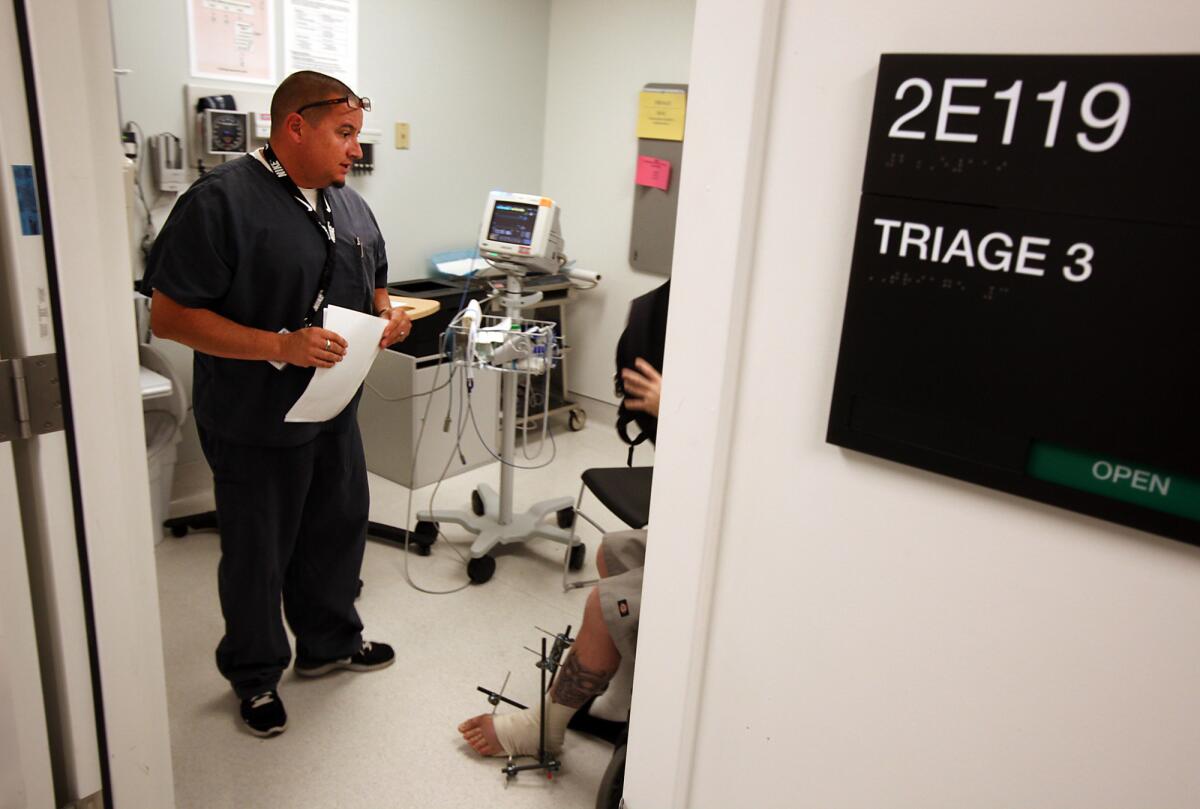Column: A big health insurer is planning to punish patients for ‘unnecessary’ ER visits

- Share via
Anthem is the nation’s second-largest health insurer, with thousands of medical professionals on its payroll. Yet its Blue Cross and Blue Shield of Georgia subsidiary has just informed its members that if they show up at the emergency room with a problem that later is deemed to have not been an emergency, their claim won’t be paid.
It’s a new wrinkle in the age-old problem of how to keep patients from showing up at the ER for just anything. But medical experts say the Georgia insurer is playing with fire. By requiring patients to self-diagnose at the risk of being stuck with a big bill, it may discourage even those with genuine emergencies from seeking necessary care. And it’s asking them to take on a task that often confounds even experienced doctors and nurses.
“Patients don’t come with a sticker on their forehead saying what the diagnosis is,” said Renee Hsia of the Institute for Health Policy Studies at UC San Francisco, who has studied the difficulty of making snap diagnoses at the ER. “We as physicians can’t always distinguish necessary from unnecessary visits.”
Blue Cross Blue Shield of Georgia, the only insurer offering individual insurance plans in 96 of the state’s 159 counties, sent letters to its enrollees in late May stating that it would refuse to cover non-emergency ER visits starting July 1. It defined inappropriate visits as any but those that “a prudent layperson, possessing an average knowledge of medicine and health,” would believe needed immediate treatment. It hoped to encourage patients with non-emergency conditions to seek help instead at an urgent care clinic or a doctor’s office.
Patients don’t come with a sticker on their forehead saying what the diagnosis is.
— Renee Y. Hsia, UC San Francisco
The “prudent layperson” language was written into the Affordable Care Act to protect patients, not subject them to retroactive second-guessing. The idea was to require insurers to base their claims payments on what an average person would consider an emergency, not on the ultimate diagnosis reached by doctors after examinations and tests at the ER.
The policy of Blue Cross Blue Shield of Georgia, however, could allow the insurer to decide for itself after a claim is submitted whether the patient actually acted prudently.
A spokesperson for Anthem didn’t respond to my query about the new policy. A spokeswoman for the Georgia insurer, Debbie Diamond, told us its goal was to control costs by steering patients away from expensive ER services and toward doctor offices or urgent care clinics when those are more appropriate settings for treatment. “People who have a cold or use the ER as their primary physician — that’s got to stop,” she said. “This really is a question of getting healthcare more affordable.”
She said the policy wouldn’t apply when the patient is 14 or younger, an urgent care clinic isn’t located within 15 miles, or the visit occurs on a Sunday or holiday. She said it’s aimed at manifestly minor ailments — “If you had cold symptoms; if you have a sore throat. Symptoms of potentially more serious conditions, such as chest pains, could be seen at the ER even if they turn out to be indigestion.”
Diamond said similar policies have been implemented with Anthem plans in New York, Missouri and Kentucky. What isn’t known is whether Anthem plans to roll out the policy in other states. The company offers insurance in 14 states, including California.
Insurers and government authorities have pondered for years how to stem unnecessary ER visits. Washington state’s Medicaid program, for instance, tried to impose an annual three-visit limit on its enrollees. After a court rejected the proposal, the program developed a list of 500 diagnoses for which it would deem ER visits unnecessary and wouldn’t pay.
But doctors argued that many symptoms on the list, which included headaches, earaches and bronchitis, could be indicators of genuinely serious conditions. Bronchitis, for example, often can’t be distinguished from pneumonia without a chest x-ray. Headaches could be symptoms of meningitis, encephalitis or hemorrhage.
Gov. Christine Gregoire quashed the plan in 2012, on the day it was to begin. Washington later instituted a program encouraging hospitals to develop systems to weed out unnecessary visits more effectively, in part through patient education and by identifying frequent visitors or patients presenting at the ER chiefly to obtain drugs.
Hsia’s research, published last year in the Journal of the American Medical Assn., found that ER doctors and triage nurses often were unable to distinguish urgent from non-urgent visits without examining the patient. Six of the 10 top reasons for unnecessary visits, including back, abdominal and chest pain and sore throats and headaches, were also among the top 10 symptoms of real emergencies. Many visits that were later deemed unnecessary “arrived by ambulance … had procedures performed, and were admitted to the hospital, including critical care units,” her group’s study found.
“Everyone in insurance, everyone in emergency medicine has stories to tell about wildly inappropriate emergency room presentations,” observed David Anderson, an insurance expert at Duke University. “The problem is that the decision to go to the emergency room is fraught with uncertainty. Most people know that something is wrong and they don’t know if it is really, really wrong or mildly wrong. … Retrospective claims review with denials is too blunt of a tool to deal with a scenario with explicit uncertainty and information gaps.”
Nor is it clear how much money could be saved by really cracking down. “The caricature is of a patient blindly visiting the ER [for no reason], but that’s relatively uncommon,” said Ari Friedman, a physician who collaborated on Hsia’s research. Policies aimed at cutting down on inappropriate visits are all based on judgments made after final diagnoses, which obviously aren’t available to patients before they decide to go to the ER.
ER services come to only 2% to 6% of total U.S. healthcare spending, Friedman said, “and most of that is spending on sick patients, not healthy ones.”
Hsia called the Blue Cross Blue Shield of Georgia rule a “well-intentioned policy with dangerous consequences for patients.” Studies have shown that efforts to use financial incentives to reduce healthcare usage often lead patients to cut down on necessary as well as unnecessary care. That was the finding of a classic Rand Corp. study in the 1970s, which found that patients subjected to co-pays did indeed use fewer healthcare services than those who got the services for free — but that they “reduced the use of both highly effective and less effective services in roughly equal proportions.”
Diamond said that Blue Cross Blue Shield of Georgia patients have access to telehealth services via smartphones and other connected gadgets, which will allow them to get a basic judgment about the seriousness of their symptoms remotely. But it’s questionable whether that’s an adequate substitute for an ER visit in all cases. Not all patients will have access to smartphones or connectivity, for one thing. For another, when even trained triage nurses can’t flawlessly judge the urgency of a patient’s condition when meeting face-to-face, a phone consultation may not be very reliable.
As Hsia said, the impetus underlying the Georgia policy is understandable in economic terms. But this Anthem subsidiary and its cousins in New York, Missouri and Kentucky have chosen a crude and counterproductive way to cut costs by putting the onus on patients to know just how serious their condition may be, at risk of what could be hundreds of dollars or more in unpaid claims. If this is the healthcare world of the future, it’s a perilous and costly place.
Keep up to date with Michael Hiltzik. Follow @hiltzikm on Twitter, see his Facebook page, or email [email protected].
Return to Michael Hiltzik’s blog.
MORE FROM MICHAEL HILTZIK
Study points to another advantage of the 1%: They’re great at evading taxes
Trump’s rollback of birth control rights will run into a legal buzzsaw
Gov. Brown wants California to borrow from itself to fund employee pensions. Good idea
More to Read
Sign up for Essential California
The most important California stories and recommendations in your inbox every morning.
You may occasionally receive promotional content from the Los Angeles Times.











